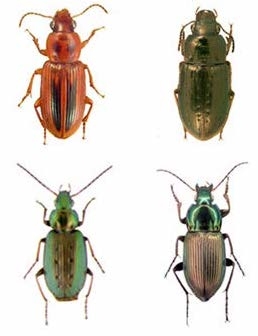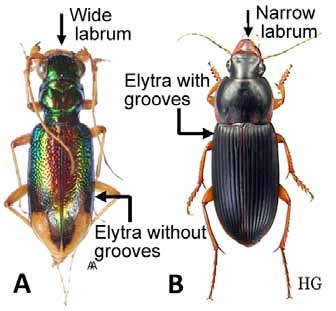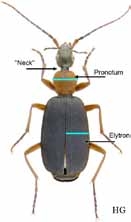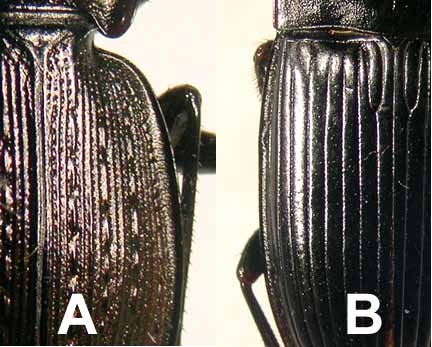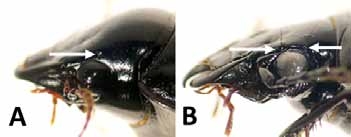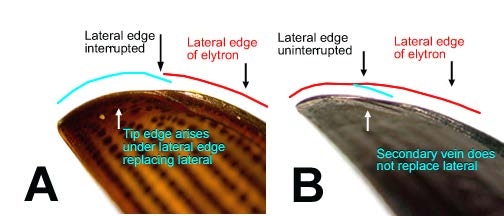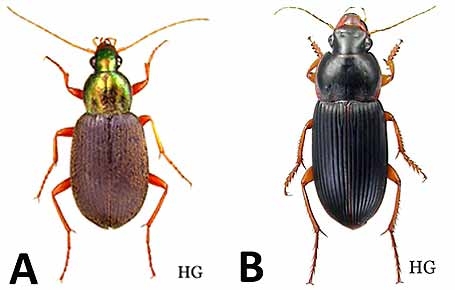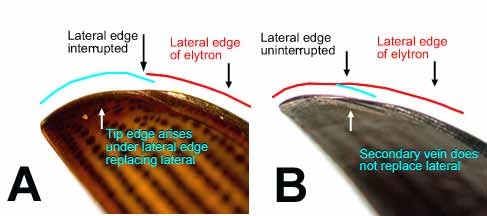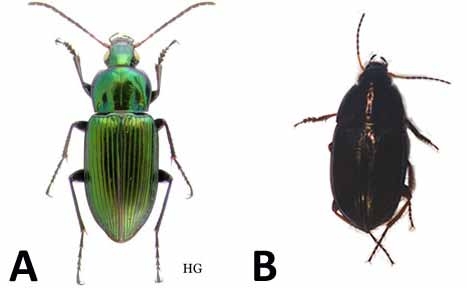This publication provides an illustrated key to the major groups (or tribes: see definition in next section) of ground beetles found in eastern North Carolina agricultural fields. Feeding habits of beetles within the same tribe are often very similar, allowing rough separation of beetles that are predators and seed feeders, for example. This document will allow accurate identification of the vast majority of ground beetle collections made in this area. For a comprehensive academic document describing all ground beetles in the region, see Ciegler (2000), listed in the reference section at the end of this document.
Although there are thirty-six currently recognized tribes of carabid beetles, this publication focuses on the nine that are most likely to be encountered in eastern North Carolina agricultural fields. The tribes presented here are based on a survey of academic literature and monthly pitfall trap collections of ground beetles taken in nine fields from July 2009 through July 2010 at the Center for Environmental Farming Systems near Goldsboro, North Carolina. The fields included a wide variety of soil types supporting hay, soybeans, or corn. The majority of beetles collected (>95 percent) were of eight species from five tribes: Carabini, Cicindelini, Harpalini, Pterostichini, Zabrini. Although specimens from the tribes Chlaeniini, Galeritini, Platynini and Scaritini were not as abundant, they were collected consistently enough to warrant inclusion here. For those less familiar with insect classification and where tribes fit into this system, see the brief description that follows.
Classification of Ground Beetles
The basic hierarchical naming system used in insect classification (taxomomy and systematics) is presented below, with examples. A complete description of insect classification, and how insects relate to other organisms, can be found at the online Tree of Life Project.
- Class (e.g. Insecta, the insects)
- Order (e.g. Coleoptera, the beetles)
- Family (e.g. Carabidae, the ground beetles)
- Tribe (e.g. Cicindelini, the tiger beetles)
- Genus (e.g. Megacephala, the big-headed tiger beetles)
- Species (e.g. Megacephala carolina, the Pan-American big-headed tiger beetles)
- Genus (e.g. Megacephala, the big-headed tiger beetles)
- Tribe (e.g. Cicindelini, the tiger beetles)
- Family (e.g. Carabidae, the ground beetles)
- Order (e.g. Coleoptera, the beetles)
This publication provides an identification tool set up as a dichotomous key, which is a logic tool using characteristics of an organism arranged into pairs of statements (couplets) that allow you to choose which statement fits the organism best. Once the choice is made, you will have identified the beetle or will be directed to following couplets until the organism is identified. Always read both couplets and examine the pictures (figures) provided before making your decision. The number in parentheses following the ”a” of each couplet (from couplet 2 on) is the number of the previous couplet.
This key uses characteristics of beetles that are identifiable using a good hand lens. For a more detailed taxonomic description of these features, see Ciegler (2000).
Key
1a With labrum (upper lip) clearly wider than gap between antennal insertions (i.e. very large mouthparts) (Figure 1A); mandibles long and with long teeth; elytra (the hardened forewing) without striations (grooves) (Figure 2A) ........................................................CICINDELINI (Tiger beetles).
Feeding Habits: predatory on ground-dwelling arthropods.
1b Not as above; gap between antennal insertions wider than labrum (Figure 1B); elytra with grooves (Figure 2B) ........................................................................................Go to couplet 2.
2.
2a (1) Body pedunculate, i.e. thorax constricted to a “waist” giving the overall appearance of a mole cricket (Figure 3); front legs flattened and modified for digging (Figure 3, circle); large beetles 15- 30mm ( 0.6-1.2 inches) ...................................................................................... SCARITINI.
Feeding Habits: predatory/ omnivorous on caterpillars, wireworms, other insects, and occasional plant matter.
2b. Not pedunculate; front legs not modified for digging ........Go to couplet 3.
3.
3a (2) Head and pronotum (upper surface of the first segment of the thorax; it’s shape is often important in beetle identification) narrow, equal to or less than the width of one elytron (hard forewing of a beetle); head narrows posterior to eyes with definite neck between head and prothorax; head and elytra black, pronotum and legs red; larger beetles 17-22 mm ( 0.7-0.9 inches)
(Figure 4)............................................................................................ GALERITINI (False bombardier beetles).
Feeding Habits: predatory/omnivorous on caterpillars and grass seeds.
3b Head and pronotum wider, or if head and pronotum narrow, not colored as above; without a defined neck; smaller beetles <17mm (<0.7 inches) .........................Go to couplet 4.
4.
4A (3) With at least 11 clearly impressed and evenly spaced grooves (striae) on each elytron (the hard forewing of a beetle); this character is most easily seen at the basal part of the elytron; i.e. closest to head(Figure 5A); often with colorful depressions (foveae) on black elytra; larger beetles, over 15mm (.6 inches), more often 20-25mm ( 0.8-1.0 inches) (Figure 6) .....CARABINI (Fiery searchers and caterpillar hunters).
Feeding Habits: predatory mainly on caterpillars often found on plants in agricultural settings.
4B With 8 striae (grooves) per elytron (Figure 5B); may be variously colored; various sizes .............................................................................Go to couplet 5.
5.
5a (4) With 1 supra-orbital setigerous puncture (a pit with a hair above the eye; the hair may be lost, leaving only the pit) (Figure 7A) ......................................................Go to couplet 6.
5b With 2 supra-orbital setigerous punctures (Figure 7B) ..........Go to couplet 7.
6.
6a (5) With an interruption of the margin of the elytra (internal plica) near the apex where the lateral edge is replaced by secondary vein (this is a difficult character to see and may require lifting an elytron to better see the edge) (Figure 8); with fine matt of velvet-like hair covering dorsum of elytra (Figure 9) .......................................................................................CHLAENIINI
Feeding Habits: predatory/omnivorous mainly on arthropods and other invertebrates, but also fungi.
6b Without an interruption of the margin (internal plica) of the elytra near the apex (the lateral edge is not replaced) (Figure 8); elytra without matt of fine hair (Figure 9) ...HARPALINI
Feeding Habits: herbivorous/omnivorous primarily on weed seeds but will also feed on other arthropods if needed.
7.
7a (5) With an interruption of the margin (internal plica) of the elytra near the apex (this is a difficult character to see and may require lifting an elytron to better see the edge) (Figure 10); with pronotum considerably wider than one elytron (Figure 11A)...................Go to couplet 8.
7b Without an interruption of the margin (internal plica) of the elytra near the apex (Figure 10); and with pronotum about the width of one elytron (Figure 11B); not metallic ....................................................................................................PLATYNINI
Feeding Habits: predatory on caterpillars, aphids, mealworms
8.
8a (7) Punctures on elytra; usually two setae (hairs) on the second segment of the labial palpi (inner finger-like palps of the mouthparts); usually black but one dominant species (Poecilus chalcites) is metallic bronze/green (Figure 12) ............................................................PTEROSTICHINI.
Feeding Habits: predatory on arthropod and other invertebrates, especially caterpillars and beetle eggs.
8b No punctures on elytra; usually many setae on the second segment of the labial palpi (inner finger-like palps of the mouthparts); oval shape, and dark bronze coloration, not metallic; commonly running about in the sun May-early June. ..................................ZABRINI (Amara is the only genus located in NC).
Feeding Habits: omnivorous on plant seeds, caterpillars.
| 1 supra orbital seta | 2 supra orbital setae | |
|---|---|---|
| Plica | Chlaeniini | Pterostichini/Zabrini |
| No plica | Harpalini | Platynini |
References
Ciegler, J. C. 2000. Ground Beetles and Wrinkled Bark Beetles of South Carolina (Coleoptera: Geadephaga: Carabidae and Rhysodidae). Biota of South Carolina Vol. 1. Clemson University, Clemson, S.C. ↵
Prepared by
Geoff Balme, Department of Entomology, NC State University
David Orr, Department of Entomology, NC State University
11-CALS-2288 AG-735-02
2/11—VB/KEL
Publication date: Feb. 1, 2011
Reviewed/Revised: Aug. 24, 2023
AG-735-02
N.C. Cooperative Extension prohibits discrimination and harassment regardless of age, color, disability, family and marital status, gender identity, national origin, political beliefs, race, religion, sex (including pregnancy), sexual orientation and veteran status.

